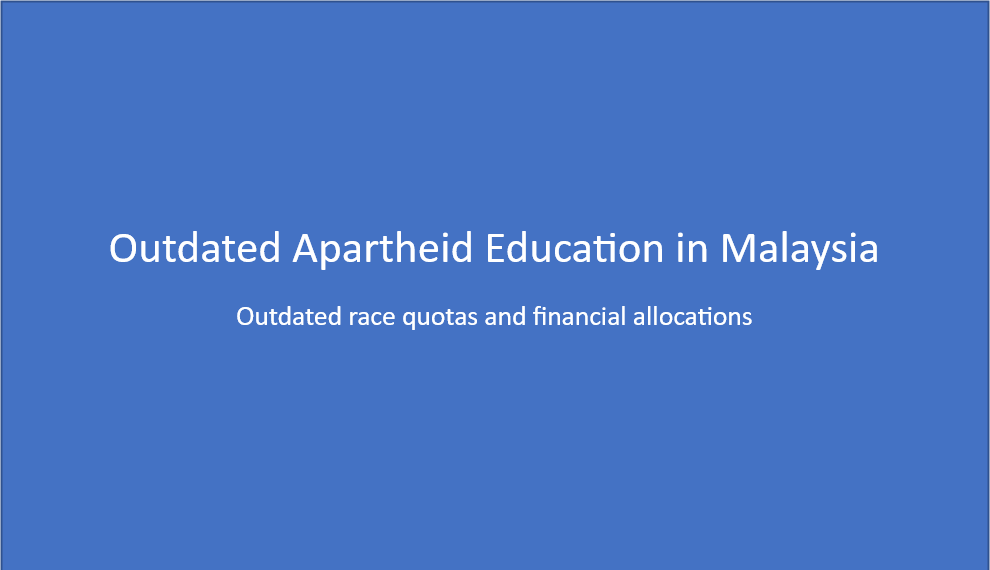
Murray Hunter
Minister of Education Fadhlina to answer questions on Indian student admission into matriculation programme
P Ramasamy
Aug 24, 2025

I would like to pose the following questions to the Minister of Education Fadhlina Sidek regarding the admission of Indian students into the much sought-after matriculation programme. Recently, she stated that the intake of 1,537 Indian students into the programme for 2025 far exceeded their quota.
Can Fadillah answer the following questions:
1. What was the total number of Chinese and Indian students admitted to the matriculation programme?
2. What was the number of Chinese students admitted?
3. What was the total number of students—Malays, Chinese, Indians, and others—admitted for the programme in 2025?
4. If the number of Indian admissions exceeded their quota in 2025, what then is the actual quota set for Indian and Chinese students?
5. Can Fadillah provide a breakdown of student admissions into the matriculation programme over the last ten years?
I understand that under the administration of former Prime Minister Najib Tun Razak, the admission of Indian students was about 2,500. If this was the case, then it would be more appropriate to say that Indians exceeded their quota, whatever the quota was, under Najib’s tenure. Therefore, on what basis can Fadhlina now claim that Indian admissions into the matriculation programme exceeded the quota this year?
Despite the stated 90:10 admission ratio between Malays and Chinese/Indian students in the matriculation programme, the policy seems shrouded in mystery and politics. Apart from the controversial allocation for Chinese and Indian students, the admission criteria itself remains unclear.
As I understand, Indian students are required to obtain a very high number of As before they can be admitted into the matriculation programme. Meanwhile, the high ratio for Malay students is justified on the principle of affirmative action—where students from rural areas are given priority. If this is the case, why can’t Indian students be given the same advantage based on the universally accepted principle of affirmative action? Just like Malays, Indians from rural areas and economically disadvantaged backgrounds also deserve greater access to the matriculation programme under less stringent requirements.
Finally, given the system of multiple pathways into universities, isn’t it time for public universities to also consider the suitability of A-Level qualifications as an alternative pre-university entry requirement?
RM19 Million for Tamil Schools – A token allocation
If I was the minister or the deputy minister in the Madani government I would be too ashamed to announce that the Tamil schools in the country obtained RM19 million for maintenance.
What is more the increase of less than a million from last year is considered negligible taking into account inflation and others.
Yet the Deputy Minister of Education Wong Kah Woh had the temerity to say that the allocation was testimony to the government’s commitment to the improvement of Tamil schools in the country.
With more than 560 Tamil schools in the country and many of them sadly in need of repairs due years of neglect the RM19.09 million allocation is nothing but a drop in the vast ocean.
The Ministry of Education headed by Minister Fadhlina Sidek receives an annual budgetary allocation of RM60 billion, the highest compared to the other ministries.
Compared to the national and Chinese vernacular schools, the Tamils schools many of them in the interior are in the worst shape physically.
One of the primary reasons why there is lack of enrolment in the rural Tamil schools is related to the conditions of these schools.
This is the reason why when I was the deputy chief minister in Penang, much emphasis was paid to the improvement of the physical infrastructure of the schools.
There was a Tamil school in Nibong Tebal, Penang, with declining student enrolment. However, after the physical infrastructure of the school was improved, enrolled tremendously improved.
It is utter shame to say that RM19 million allocation to the Tamil schools for the improvement of the physical infrastructure is an example of the Madani government’s commitment to Tamil vernacular education.
Far from it; the meagre allocation is testimony to the government’s disinterest in the Tamil schools.
It already predicted if some Tamil schools are not improved in the near future, the chances of these closing down seems rather imminent.
If this happens, the government has to take the full responsibility.
***
Undeniably the Malaysian Indians have been the most deprived, though there are very rich Towkays, Tycoons and Rich blokes amongst them who unlike the Chinese, have done frigg-all or nothing substantial for the Indian poor.
Additionally, Dr Tajudin Rasdi has just warned us (nons) that the Malays aren't likely to be sympathetic as they are deep-set on, having been indoctrinated for decades, clinging to their ketuanan status, which has been exactly why education accessibility has long been lopsided, and biased towards the ketuanan Elite. Nothing much will change, sadly for the Indians.
No comments:
Post a Comment